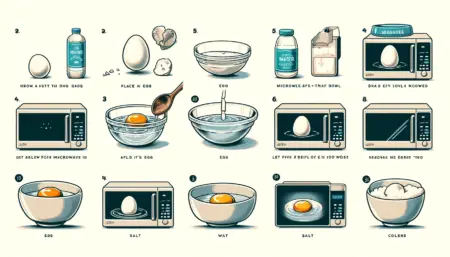

oiling an egg in the microwave is a quick and easy method when you’re short on time or don’t have access to a stove. However, it’s important to follow specific steps to avoid any mishaps. Here’s how you can safely and efficiently boil an egg using your microwave.
What You’ll Need:
- Eggs
- Microwave-safe bowl
- Water
- Salt
- Fork or pin
- Microwave-safe plate
- Oven mitts or a kitchen towel
Step-by-Step Instructions:
Step 1: Prepare Your Ingredients
Before you begin, gather all the necessary items. Choose fresh eggs, as they tend to cook better and are less likely to explode in the microwave.
Step 2: Pierce the Egg
Using a fork or a pin, carefully pierce a small hole in the bottom (wider end) of the egg. This step is crucial because it allows steam to escape during cooking, preventing the egg from bursting.
Step 3: Add Water and Salt to the Bowl
Fill a microwave-safe bowl with enough water to completely submerge the egg. Add about half a teaspoon of salt to the water. The salt helps prevent the egg from exploding and makes peeling easier after cooking.
Step 4: Submerge the Egg
Gently place the egg into the bowl of water, ensuring it is fully submerged. If necessary, place a microwave-safe plate on top of the bowl to keep the egg underwater.
Step 5: Microwave the Egg
Place the bowl in the microwave. The cooking time will vary depending on your microwave’s power and how you like your eggs. Here’s a general guideline for a medium-sized egg:
- Soft-Boiled: Microwave on high for 3-4 minutes.
- Medium-Boiled: Microwave on high for 5-6 minutes.
- Hard-Boiled: Microwave on high for 7-8 minutes.
Keep an eye on the egg while it cooks, especially the first time you try this method, to avoid overcooking or undercooking.
Step 6: Let the Egg Sit
After the microwave stops, leave the egg in the hot water for an additional minute or two. This helps complete the cooking process.
Step 7: Remove the Egg
Using oven mitts or a kitchen towel, carefully remove the bowl from the microwave. The water and bowl will be very hot, so handle with caution.
Step 8: Cool the Egg
Transfer the egg to a bowl of cold water or run it under cold tap water for a few minutes. This stops the cooking process and makes the egg easier to handle and peel.
Step 9: Peel and Enjoy
Once the egg is cool enough to handle, gently tap it on a hard surface to crack the shell and peel it off. Rinse the egg to remove any remaining shell fragments.
Tips and Tricks:
- Use fresh eggs: Fresh eggs cook better and peel more easily.
- Monitor closely: Microwaves vary, so keep an eye on the cooking process, especially the first time you try this.
- Experiment with timing: If the egg isn’t cooked to your liking, adjust the cooking time in 30-second increments.
Safety Precautions:
- Pierce the egg: Always pierce the egg before microwaving to prevent it from exploding.
- Use a microwave-safe bowl: Ensure the bowl and plate are microwave-safe to avoid accidents.
- Handle with care: The bowl and water will be extremely hot, so use oven mitts or a kitchen towel when removing from the microwave.
Boiling an egg in the microwave is a convenient alternative to traditional stovetop methods. By following these steps and safety tips, you can enjoy perfectly boiled eggs in just a few minutes.
Conclusion
In conclusion, yes, you can boil an egg in the microwave if you follow the proper steps to ensure a safe and successful result. By pricking a small hole in the eggshell and microwaving it in water, you can enjoy a perfectly boiled egg in just a matter of minutes. So, next time you’re in a rush and craving a boiled egg, give the microwave method a try and see how easy it can be!